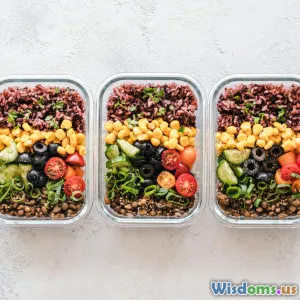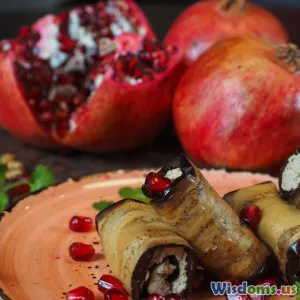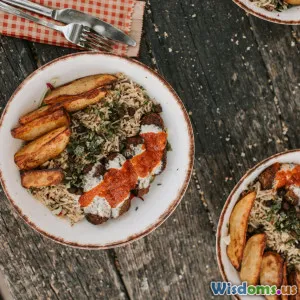
Are Kids Missing Out The Truth About StoreBought Snacks vs Homemade
9 min read Exploring how homemade snacks outperform store-bought alternatives for kids' health, taste, and creativity. (0 Reviews)
Are Kids Missing Out? The Truth About Store-Bought Snacks vs Homemade
Introduction
In an age dominated by convenience and fast-paced lifestyles, the ubiquity of store-bought snacks for children has skyrocketed. From colorful packaging to catchy jingles, these snacks are deeply embedded in the culture of childhood snacking. But beneath the appealing surface lies a question rarely asked: Are kids truly benefiting from these convenient options? Could the shift away from homemade snacks be causing children to miss out on essential nutrients, flavors, and experiences?
This article explores the nuanced differences between store-bought snacks and their homemade counterparts, analyzing health impacts, economic factors, and developmental opportunities. We go beyond generalizations with data, real-world insights, and practical examples to reveal whether kids today are indeed losing out.
The Nostalgia and Evolution of Snacking
Snacking, especially for children, has long been a part of daily life—whether it was grandma’s freshly baked muffins or a quick fruit sandwich packed from home. Before the rise of processed foods, most snacks were homemade, utilizing fresh and whole ingredients.
The Rise of Store-Bought Snacks
According to the USDA, the average American child consumes about 34% of their daily calories from snacks, with a significant portion coming from processed, packaged foods. Brands like Goldfish crackers, fruit snacks, and pre-packaged cookies are convenient but often heavy in sugar, artificial ingredients, and preservatives.
The food industry capitalizes on convenience and marketing targeted at children. Bright colors, mascots, and free toys within packages are designed to attract kids—often overshadowing the nutritional value.
Nutritional Showdown: Store-Bought vs Homemade
Ingredient Transparency
One of the biggest challenges with store-bought snacks is the lack of ingredient transparency for consumers. Products can contain additives such as high fructose corn syrup, artificial flavors, emulsifiers, and trans fats. For example, a standard fruit snack pack may boast “made with real fruit juice” but also contain significant added sugars and artificial colorings.
Conversely, homemade snacks give complete control over ingredients. Parents can opt for whole grains, natural sweeteners like honey or maple syrup, and fresh fruits or nuts. This control can reduce exposure to potentially harmful additives.
Nutrient Density and Sugar Content
Studies show that most commercially available children’s snacks are not nutrient-dense. According to a study published in Pediatrics, nearly 70% of store-bought children’s snacks exceed the recommended daily sugar intake recommendations for kids—sometimes in a single serving.
In homemade alternatives, such as banana oatmeal cookies or veggie-packed muffins, sugar levels can be regulated, and additional nutrients like fiber, vitamins, and minerals are preserved.
Snack Examples
- Store-Bought: A single 30g pack of strawberry fruit snacks contains roughly 25g of sugar, 110 calories, and often lacks fiber.
- Homemade: A homemade trail mix combining nuts, dried unsweetened cranberries, and small amounts of dark chocolate can offer healthy fats, fiber, antioxidants, and lower sugars in a portion-controlled manner.
Economic Considerations: Cost vs Value
At first glance, store-bought snacks might seem more cost-effective due to bulk production and unlimited shelf life. However, a deeper analysis reveals nuances.
Long-Term Cost of Health
Regular consumption of processed, sugar-laden snacks is linked to increased risks of childhood obesity and diabetes. According to the CDC, childhood obesity rates have soared over the past decades alongside increased consumption of processed foods.
The subsequent medical expenses and long-term health costs can overshadow any short-term savings on convenience snacks.
Ingredient Shopping and Preparation Time
Homemade snacks require upfront efforts: shopping, preparation, and cleaning. Ingredients like oats, flour, fruits, and nuts may cost more initially but can yield multiple servings.
For example, baking a batch of homemade granola bars might cost $5 in ingredients but produce 10 bars, each cheaper and healthier than their packaged counterparts.
The Role of Snacking in Childhood Development
Encouraging Creativity and Self-sufficiency
Involving children in making their own snacks fosters important skills such as cooking, measuring, and understanding ingredients. This involvement promotes knowledge about nutrition and food origins.
Chef and child nutrition advocate Jamie Oliver states, “When kids understand what’s in their food and help prepare it, they make better choices and develop lifelong healthy habits.”
Building Taste Preferences
Exposure to a variety of flavors in natural forms during childhood influences taste preferences positively. Homemade snacks often contain fresh fruits, vegetables, seeds, and spices that expand a child’s palate beyond the repetitive sweetness and saltiness of industrial snacks.
Emotional Connection and Family Bonding
Snack time can be an opportunity to bond. Preparing and sharing homemade goodies with family nurtures emotional well-being. Food psychologist Dr. Julie Matthews highlights this, saying, “Food is not just nourishment but connection.”
Environmental Impact
Packaging Waste
Store-bought snacks generate a significant amount of single-use plastic waste. A 2019 study found that packaged snack foods contribute substantially to household plastic trash, often ending up polluting waterways.
Homemade snacks typically reduce or eliminate plastic usage—using reusable containers or compostable materials, thereby decreasing environmental footprint.
Food Sustainability
Choosing homemade snacks using seasonal and local ingredients supports sustainable agriculture and minimizes carbon footprint compared to commercially processed, transported, and packaged products.
Challenges and Practical Tips for Homemade Snacking
While the benefits of homemade snacks are clear, parents often face challenges: time constraints, culinary skills, and children’s picky eating habits.
Overcoming Barriers
- Batch Prep: Dedicate a weekend afternoon to prep several snack options that can be refrigerated or frozen.
- Simple Recipes: Use no-bake or minimal ingredient recipes like yogurt parfaits, energy balls, or fruit kabobs.
- Involve Kids: Let children participate in selecting recipes and ingredients to boost enthusiasm.
- Smart Substitution: Gradually swap out processed snacks with healthier homemade versions to ease transitions.
Leveraging Technology
Use apps and websites that provide kid-friendly, nutritious snack recipes with user reviews.
Partnering with Schools
Advocate for healthier snack policies or programs that encourage homemade or freshly prepared snacks in schools.
Conclusion
Kids today potentially miss out when store-bought snacks dominate their diets, experiencing not only diminished nutritional value but also reduced exposure to learning opportunities and sensory experiences that homemade snacks provide. While convenience will always play a role in busy family routines, prioritizing homemade options enriches children's health, fosters creativity, and nurtures emotional connections.
Encouraging a return to thoughtfully prepared, homemade snacks complements a holistic approach to child development and nutrition. It’s not merely about what children eat, but how engaging with wholesome food positively shapes their lifelong relationship with nutrition, environment, and culture.
Making the conscious choice to incorporate homemade snacks, even gradually, empowers families to reclaim snack time as an important facet of health and happiness for children.
By bridging the practical, nutritional, and emotional elements, this article aims to transform perceptions and inspire positive change regarding childhood snacking habits.
Rate the Post
User Reviews
Popular Posts

















